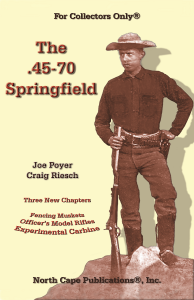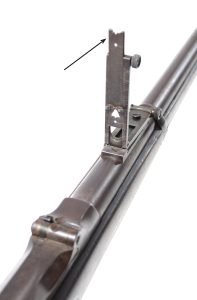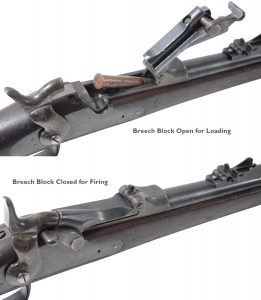 To learn more, visit www.northcapepubs.com or email [email protected].
To learn more, visit www.northcapepubs.com or email [email protected].
To purchase a .45-70 Springfield rifle on GunsAmerica.com, click this link: https://www.gunsamerica.com/Search.aspx?T=trapdoor.
Editor’s Note: If you would like to explore the .45-70 Springfield in greater detail, obtain a copy of The .45-70 Springfield, 5th Revised Edition by Joe Poyer and Craig Riesch from North Cape Publications, Inc., P.O. Box 1027 Tustin CA 92781. The price is $22.95 plus $5.75 postage. The book contains a narrative history of the development and use of the Springfield “Trapdoor” as well as detailed descriptions of the various models, their parts as they changed during their long production, and all markings and serial numbers.
Hollywood legend has it that the gun that “Won the West” was the Winchester Model 1873 Jimmy Stewart struggled to keep in the movie Winchester ’73. In fact, it was the U.S. Model 1873 .45-70 Springfield, better known to modern day collectors and shooters as the “.45-70 Trapdoor” for its top-opening breech block, that truly “Won the West.”
The lever-action Winchester ’73 was most commonly chambered in a short, semi-bottle-necked cartridge dubbed the .44-40. A round that could be chambered in both handguns and rifles, when it was fired from a rifle it had limited range and power. The Winchester Model 1873 also had numerous openings through which dirt and rain could enter to foul the action.

U.S. Springfield Model Rifles, top to bottom: Model 1865, .58-65 caliber; Models 1866, 1868 and 1870, in .50-70 caliber; Models of 1873, 1877, 1884 and 1888, in .45-70 caliber.
The Answer?
As a result, the U.S. Army never seriously considered the Winchester lever rifle for adoption. What they did adopt was the much stronger “trapdoor action” designed by Colonel Hiram Berdan and improved by Springfield Armory employee Erskine S. Allen. This action employed a long, straight cartridge holding a .456 diameter lead, round nose bullet weighing 405 grains (later changed to 500 grains) and which had an effective range up to 2,400 yards. It smacked its target with nearly four times the energy of the .44-40 cartridge.

The Winchester Model 1873. It did not have the range and striking power for military service as perceived by the U.S. Army.
The recent unpleasantness between the North and South had shown the importance of massed, long-range fire from a rifle-musket. The U.S. Army’s officers of all ranks had “seen the elephant” and knew how deadly massed fire could be at long ranges.
The only real antagonists the United States Army faced in the post-war years were Native American tribesmen who conducted (using a modern term) an insurgency, employing hit-and-run tactics. They tended to avoid set-piece battles unless the enemy was at a distinct disadvantage (as were Captain William J. Fetterman and Lieutenant Colonel George Custer, who were attacked at close range and quickly overwhelmed at The Battle of the Little Bighorn).
The favored method of attack on armed settlers and soldiers was from a distance. A well-trained Indian horse carrying a rider could cover up to one mile in four minutes or so. A Springfield rifle or carbine could be reloaded and fired twelve times a minute by a trained soldier, but probably only eight to ten times under the stress of combat.
Native American troops often gathered within sight, but at distances of a half a mile or so, to harass their intended victims before attacking. Assuming the soldiers began firing volleys at extreme range and it took two or three minutes for the recipients to realize they were under fire and organize to charge, and two to four minutes to ride close enough for their shorter-range weapons to have an effect, the soldiers would have fired a minimum of fifteen to thirty-five volleys at the charging foe that would have emptied enough saddles of the tribe’s most precious commodity, manpower.
Gun Details
The Springfield Rifle of the mid-1860s through the 1890s came in seven distinct models: The Model 1865 which fired a .58-65 cartridge; the Models of 1866, 1868 and 1870 which fired the .50-70 cartridge, and the Models of 1873, 1884 and 1888 chambered for the revered .45-70 cartridge.
The new Model 1866 Springfields firing the .50-70 cartridge enabled massively outnumbered soldiers to stand off successive attacks like those at the Hayfield and Wagon Box Fights in 1866. The Model 1866 and 1868 .50-caliber “needle guns” as the Springfields were then known (because of the long firing pin required by the long “trapdoor” action) were also used in the campaigns of 1868-69 and the Red River War. But in 1873, a new model of the Springfield firing a powerful, and longer-ranged .45 caliber cartridge filled with 70 grains of black powder (the .45-70) was released to the troops. It received its first real combat test during the 1876 summer campaign against the alliance of Sioux, Cheyenne and Arapaho. At the Battle of the Rosebud, for instance, over 40,000 rounds were fired by the soldiers and their Crow and Shoshoni allies. Long-range rifle fire from two infantry companies saved Lt. Colonel William B. Royall and his outnumbered battalion of cavalry from annihilation.

The U.S. Model 1884 Springfield Rifle Rear Sight. The sight ladder is calibrated from 100 to 1,800 yards while the notch at the very top of the sight ladder is calibrated for 2,400 yards or 1.3 miles.
During the next twenty-five years, the .45-70 Springfield would finally tame the West in the hands of the U.S. Army at the Nez Perce War, the Apache Campaigns and numerous smaller actions. The .45-70 Springfields would also see widespread use during the Spanish-American War in Cuba, Puerto Rico and the Philippines.
How It Works
The Springfield “Trapdoor”, as the rifle is known to modern collectors and shooters, was a remodeled single-shot Civil War rifle-musket. Indeed, the Models of 1865 and 1866 were actually Model 1863 rifle-muskets in which breech end of the barrel was cut open and the breech block assembly bolted on. To load and fire, the soldier lifted the thumb latch on the right side to open the breech block. The cartridge was inserted, the breech block snapped shut, the hammer cocked, the rifle sighted and the trigger pulled.
The .50-70 and .45-70 cartridges had high arcing trajectories that made them very effective at long ranges when fired in volleys. Due to differences in barrels and bores, wind conditions along the trajectory, and individual variations in point of aim among soldiers firing the volley, the bullets would all arrive at the distance indicated on the rear sight leaf at about the same time but dispersing in a large oval. It proved to be very effective. In fact, rifle volley fire was only made obsolete as an infantry tactic by machine guns which used the same principle.
The Springfield “Trapdoor” rifle has developed a devoted clique of collectors, while still retaining relatively modest prices. Over 568,300 .45-70 Springfields were manufactured between 1873 and 1894 in three rifle models and two carbine models. After service with the regular army, they were still found in National Guard armories as late as World War I. They are an important aspect of American history and retain the romance of the Old West. Be sure to take a look at GunsAmerica.com for Trapdoors you can buy for your own collection.
 Editor’s Note: If you would like to explore the .45-70 Springfield in greater detail, obtain a copy of The .45-70 Springfield, 5th Revised Edition by Joe Poyer and Craig Riesch from North Cape Publications, Inc., P.O. Box 1027 Tustin CA 92781. The price is $22.95 plus $5.75 postage. The book contains a narrative history of the development and use of the Springfield “Trapdoor” as well as detailed descriptions of the various models, their parts as they changed during their long production, and all markings and serial numbers.
Editor’s Note: If you would like to explore the .45-70 Springfield in greater detail, obtain a copy of The .45-70 Springfield, 5th Revised Edition by Joe Poyer and Craig Riesch from North Cape Publications, Inc., P.O. Box 1027 Tustin CA 92781. The price is $22.95 plus $5.75 postage. The book contains a narrative history of the development and use of the Springfield “Trapdoor” as well as detailed descriptions of the various models, their parts as they changed during their long production, and all markings and serial numbers.
To learn more, visit www.northcapepubs.com or email [email protected].
To purchase a .45-70 Springfield rifle on GunsAmerica.com, click this link: https://www.gunsamerica.com/Search.aspx?T=trapdoor.
